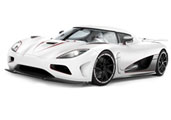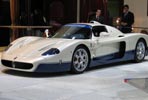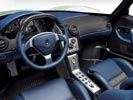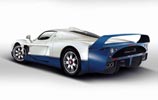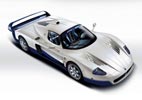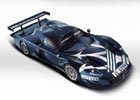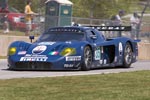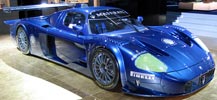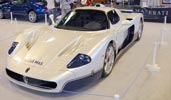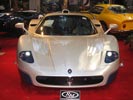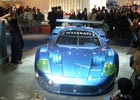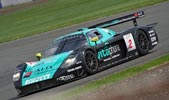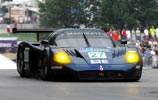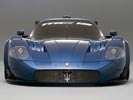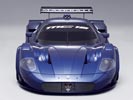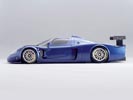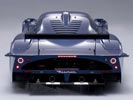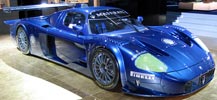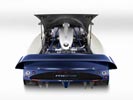The Maserati MC12 is a grand tourer produced by Maserati to allow a racing variant to compete in the FIA GT Championship. The car entered production in 2004 with 30 cars produced (five of which were not for sale). A further 25 were produced in 2005 making a total of 50 Maserati MC12 cars available for customers.
Maserati designed and built the car on the chassis of the Enzo Ferrari but the final car is much larger. The MC12 is longer, wider and taller than the Enzo Ferrari, which has faster acceleration and a higher top speed. The top speed of the Maserati MC12 is 330 kilometres per hour (205 mph) whereas the top speed of the Enzo Ferrari is 350 kilometres per hour (217.5 mph).
The Maserati MC12 was developed to signal Maserati's return to racing after 37 years. The road version was produced to homologate the race version. One requirement for participation in the FIA GT is the production of at least 25 road cars. Three GT1 race cars were entered into the FIA GT with great success. Maserati began racing the MC12 in the FIA GT toward the end of the 2004 season, winning the race held at the Zhuhai International Circuit. The racing Maserati MC12 s were entered into the American Le Mans Series races in 2005 but exceeded the size restrictions and consequently paid weight penalties.
Development of the Maserati MC12 began while Maserati was owned by Ferrari in order to create a race car for Maserati that would be eligible to compete in the FIA GT. Its initial name was the MCC, meaning Maserati Corse Competizione, and development under the direction of Giorgio Ascanelli was planned to be simultaneous with that of the MCS, the road going version. The Maserati MC12 body shape was developed from an idea by Giorgetto Giugiaro during wind tunnel testing, though the majority of styling was by Frank Stephenson. The MCC had a very similar body shape to the MC12 but there were several key differences, most notably the rear spoiler.[2] Andrea Bertolini was the chief test driver throughout the development (although some testing was done by Michael Schumacher), frequently testing the MCC at the Fiorano Circuit. As the MCC was developed further, word of the MCS ceased and eventually the final name, MC12, was announced.
The car is based heavily on the Enzo Ferrari, sharing the same Ferrari Dino V12 engine with slight modifications, the same gearbox (but renaming it Maserati Cambiocorsa) and the same chassis and track (length of axle between the wheels). The Maserati MC12 has its own bodywork which is wider, longer and slightly taller leaving the windshield as the only externally visible component shared with the Enzo. This extra size allows for greater downforce across the whole body, adding to that of the two metre spoiler.
The Maserati MC12 coupe with a targa top roof, although the detached roof cannot be stored in the car. The mid-rear layout (engine between the axles but behind the cabin) keeps the centre of gravity in the middle of the car, which increases stability and improves the car's cornering ability. The standing weight distribution is 41% front: 59% rear; at speed however, the downforce provided by the rear spoiler affects this such that at 200 kilometres per hour (125 mph), the effective weight distribution is 34% front: 66% rear.
Interior
Even though the car is designed as a homologation vehicle and is a modification of a racing car, the interior is intended to be luxurious. The interior is a mix of gel-coated carbon fibre, blue leather and silver "Brightex": a synthetic material which was found to be "too expensive for the fashion industry." The centre console features the characteristic Maserati oval analogue clock and a blue ignition button, but it has been criticised for lacking a radio, car stereo or a place to install an aftermarket sound system.[10][12]
Exterior
The body of the car, made entirely of carbon fibre, has undergone extensive wind tunnel testing to achieve maximum downforce across all surfaces. As a result, the rear spoiler is two metres (79 in) wide but only 30 millimetres (1.2 in) thick, the underside of the car is smooth, and the rear bumper has diffusers to take advantage of ground effect. Air is sucked into the engine compartment through the air scoop; its positioning on top of the cabin makes the car taller than the Enzo. The exterior is available only in the white and blue colour scheme, a tribute to the America Camoradi racing team that drove the Maserati Tipo Birdcages in the early 1960s. The car is noted for the awkwardness that results from its size: very long and wider than a Hummer H2. This, combined with the lack of a rear window, makes parking the Maserati MC12 very difficult.
Engine
The Maserati MC12 sports a 232 kilogram (511 lb), six-litre (5,998 cc/366 cu in) Enzo Ferrari-derived V12 engine, mounted at 65°. Each cylinder has four valves, lubricated via a dry sump system, and a compression ratio of 11.2:1. These combine to provide a maximum torque of 652 newton metres (481 lbf·ft) at 5500 rpm and a maximum power of 465 kilowatts (632 PS/621 bhp) at 7500 rpm. The redline rpm is indicated at 7500-despite being safe up to 7700-whereas the Enzo has redline at 8200 rpm.
The Maserati MC12 can accelerate from 0-100 kilometres per hour (62 mph) in 3.8 seconds (though Motor Trend Magazine managed 3.7 seconds) and on to 200 kilometres per hour (125 mph) in 9.9 seconds. It can complete a standing (from stationary) quarter mile in 11.3 seconds with a terminal speed of 200 kilometres per hour (125 mph) or a standing kilometre in 20.1 seconds. The maximum speed of the Maserati MC12 is 330 kilometres per hour (205 mph).
The Maserati MC12 power is fed to the wheels through a rear-mounted, six-speed semi-automatic transmission. The gearbox is the same as the Enzo's transmission (tuned to different gear ratios) but renamed "Maserati Cambiocorsa". It provides a shift time of just 150 milliseconds, and is mechanical with a 215 millimetre (8.5 in) twin plate dry clutch.
Car - Maserati MC12
Copyright © 1998-2013 you.com.au

